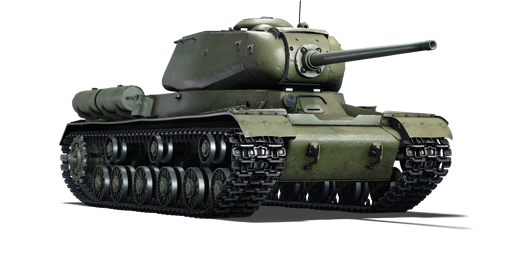



The IS-1 is the first variant of the IS heavy tank family. The new IS-1 was intended to overcome the lack of firepower and protection issues of the KV series with a whole new sloped hull design. This was a strong armour design intended to deflect or withstand projectiles from all sides. The only major design requirement was that the weight not surpass that of the interim KV-85. The new armament was the same as the KV-85, an outstanding 85 mm D-5T tank gun with significantly higher range and muzzle velocity than prior Soviet heavy tanks. The turret was also identical to that of the KV-85, with three crews. The drivetrain was similar to that of the KV-85, with enormous tracks supported by three pairs of double return rollers and six double-tired wheels suspended by massive torsion arms. Extra fuel tanks were fitted to the rear of the hull, as with all earlier heavy tanks, and massive mudguards housed storage boxes. The engine was replaced with a new V2-IS 12-cylinder diesel engine producing 520 horsepower. The typical top speed was 37 km/h, and the practical range was only 150 km. Chelyabinsk Kirov Plant was responsible for the IS-1 manufacturing, and the first IS-1 rolled off the line in October 1943, but production was halted in January 1944 as the IS-1 was swiftly replaced by the all-round better IS-2. As a result, only 200-207 units were produced in total.
Introduced in the Closed Beta Test for Ground Forces before Update 1.41, the IS-1 has slightly superior hull protection than the interim KV-85. Tank shells can be easily deflected at long ranges thanks to a unique sloped frontal hull. However, the hull's lower front armour plate remains a weakness, and nearly all opponents in its rank are able to penetrate it. The visual characteristics of the IS-1 are also comparable to those of the KV-85. Players who have previously played the KV-85 should have little difficulty adjusting to this vehicle. The IS-1, unlike its predecessor, was developed with the purpose of breaching enemy heavy defences and engaging hostile armoured vehicles in mind and, as such, has thicker sloping armour, a slightly longer chassis, a more powerful 85 mm D-5T tank gun, and a larger, rounder turret.
| Ammunition | Type | Armor penetration (mm) at a distance: | |||||
|---|---|---|---|---|---|---|---|
| 10 m | 100 m | 500 m | 1000 m | 1500 m | 2000 m | ||
| APHE | 148 | 143 | 126 | 106 | 90 | 77 | |
| HE | 19 | 18 | 17 | 16 | 15 | 14 | |
| APHEBC | 135 | 133 | 124 | 114 | 104 | 95 | |
| APCR | 195 | 187 | 154 | 122 | 96 | 76 | |
| Belt | Belt filling | Armor penetration (mm) at a distance: | |||||
|---|---|---|---|---|---|---|---|
| 10 m | 100 m | 500 m | 1000 m | 1500 m | 2000 m | ||
| AP-I/API-T | 13 | 12 | 7 | 3 | 2 | 0 | |












Mobility | |
|---|---|
Protection |
|---|
Firepower | |
|---|---|